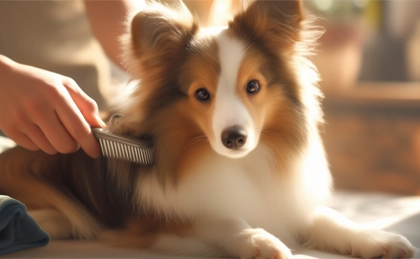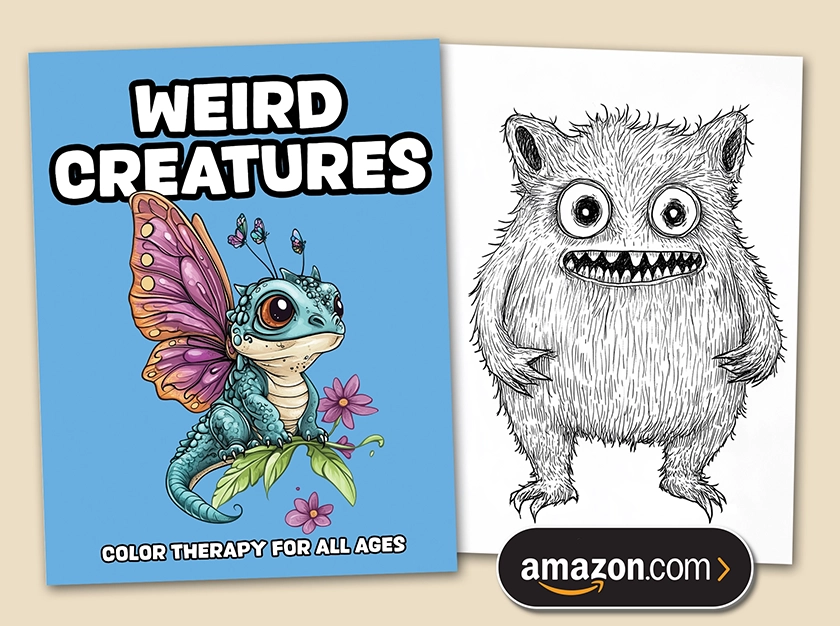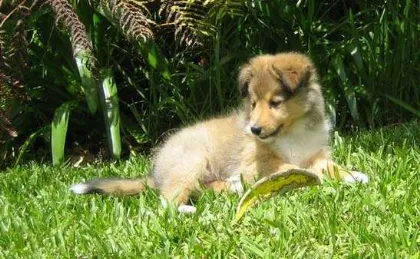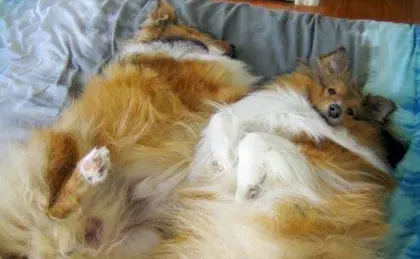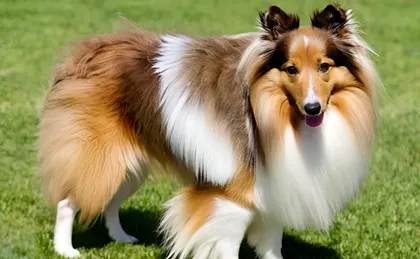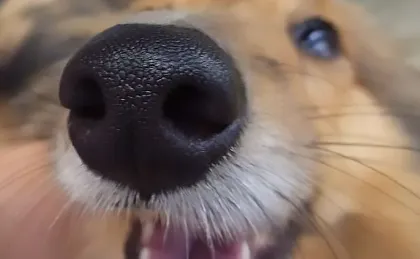Did you know that Blue Merle Shelties are actually Tri Colors in disguise? The black in their coat has been diluted down to blue or gray, thanks to the Merle gene interrupting the major Sheltie color gene. Here are 6 facts about these gorgeous beasts that may surprise you.
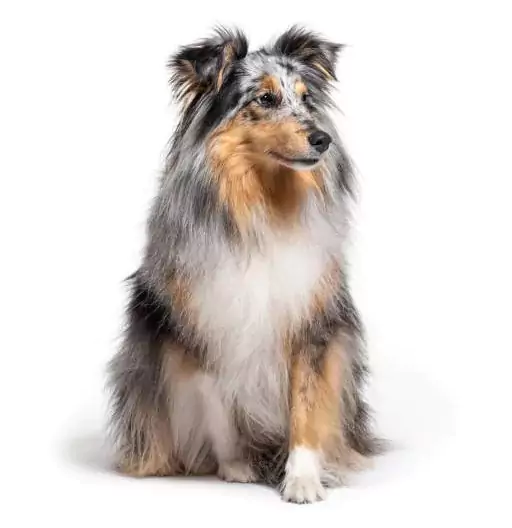
The Blue Merle Sheltie is actually black diluted to gray-blue.
#1. Blue Merle Shelties have a modifier gene
The main color gene in Shelties is the Agouti gene, and it drives that base coat color of tan or black. Officially, it comes in three flavors: Sable, Tri Color, and Bi Color.
But there are at least 11 Sheltie color genes that interact with the Agouti gene. One of them is the Merle gene, which dilutes the Agouti fur in a dapple pattern. It has two forms: Merle and Non-Merle. In Blue Merle Shelties, the Merle gene reduces melanin production and creates their characteristic blue or gray fur. It creates a striking appearance, with a mix of dark and light patches that make each Blue Merle Sheltie unique. The Merle gene is not carried by Sable or Tri-Color Shelties.
The stunning face coloring of a Blue Merle Sheltie, often with a mixture of blue, black, and white, is due to the distribution of this gene. This dapple pattern can vary greatly, with some Blue Merles showing large patches of blue-gray fur, while others may have a more speckled or marbled appearance.
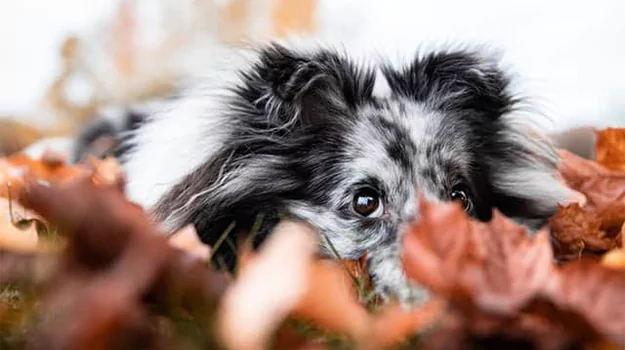
The gorgeous face coloring of a Blue Merle Sheltie.
#2. Blue Merles can have blue eyes
Melanin also affects eye color, so Blue Merle Shelties can have at least one blue eye, while the other eye is typically brown. Blue Merles can also have two brown eyes, two blue eyes, or even heterochromia (one-and-a-half blue eyes).
The blue eye color in Blue Merle Shelties is caused by the Merle gene's effect on melanin production in the iris. This phenomenon is known as "wall eye" and it's quite common in merle-coated dogs. Blue eyes in Shelties can vary from a pale, almost white-blue to a deep, vivid blue, adding to their unique and enchanting appearance.
A Blue Merle Sheltie with two blue eyes is a rare sight and highly prized by Sheltie enthusiasts. Two blue eyes can give these dogs an otherworldly look, enhancing their already captivating presence.
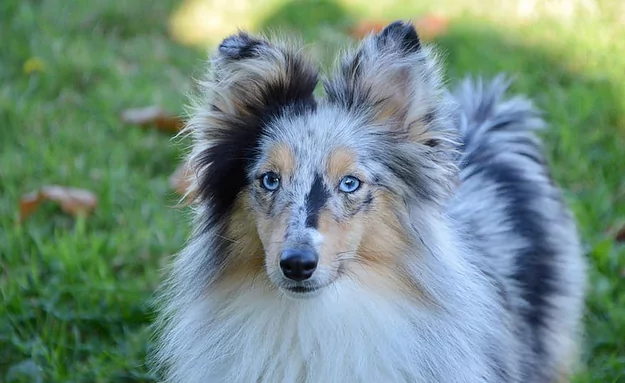
A Blue Merle Sheltie with two blue eyes.
#3. Bi Blue Shelties also have the Merle gene
The Merle gene can affect all the Agouti variants:
- Tri Color + Merle = Blue Merle Sheltie
- Bi Color + Merle = Bi Blue Sheltie
- Sable + Merle = Sable Merle Sheltie
Bi Blue Shelties have a distinctive appearance, with their blue-gray coat often accompanied by patches of black and white. This combination creates a striking contrast that makes Bi Blue Shelties stand out even more. To learn more about these genes, see my detailed article on Sheltie color genetics.
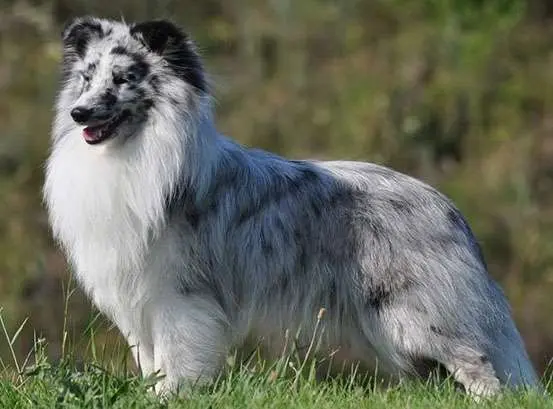
Black Agouti allele + Merle allele = Bi Blue Merle Sheltie.
#4. Double Merle Shelties have malformed eyes
Breeding any two Merles together can result in Double Merle Shelties, also known as Double Dilute or Lethal White. These Shelties have two copies of the Merle gene (MM), leading to a total lack of pigment. Double Merle Shelties have a predominantly white coat, giving them a ghostly, ethereal appearance. While this is visually striking, it's accompanied by significant health challenges.
The lack of pigment caused by the Double Merle combination causes incomplete development of the eyes and inner ear nerve endings while growing in the womb, leading to blindness and deafness. It's common for Double Merle puppies to be born with very small or non-functional eyes. Some are born with no eyes at all.
To avoid this, never breed two Merles together, as each individual offspring has a 25% chance of inheriting the MM genotype. Since Shelties have litters of 4-6 puppies, statistically, one puppy in the litter has a 100% chance of being born a Double Merle.
| M = Merle | m = No Merle | |
| M = Merle | MM = Double Merle | Mm = Merle |
| m = No Merle | mM = Merle | mm = No Merle |
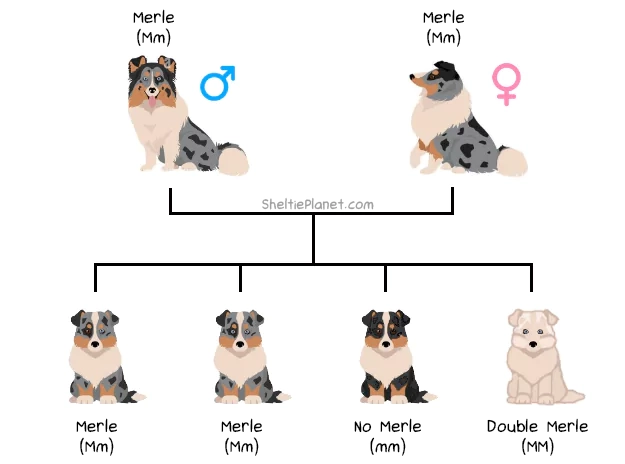
#5. Cryptic Merles hide the Merle pattern
Cryptic Shelties carry a Merle gene that's barely expressed, appearing as Tri Color but having the hidden potential to produce Double Merle puppies. Breeders often use pedigrees or dog DNA tests to identify such patterns of inheritance.
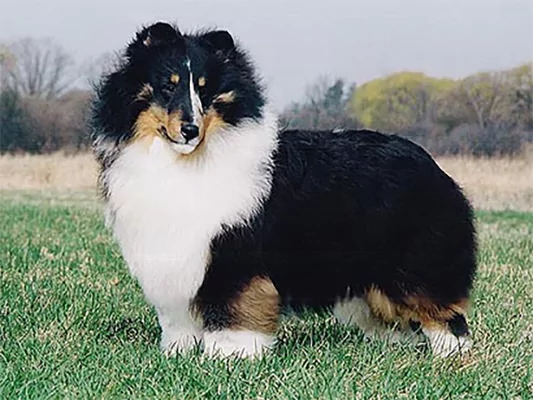
Rebel, a cryptic Blue Merle Sheltie who appears Tri Color, by Belmark Shelties.
Cryptic Blue Merles can be particularly challenging for breeders because their Merle gene is not visibly apparent. This hidden gene can unexpectedly combine with another Merle gene in breeding, producing Double Merle offspring with the associated health risks.
Traditionally, breeders referred to pedigrees to trace the genetic lineage of each parent and identify the patterns of inheritance. Nowadays, they can gain more insight by performing a dog DNA test. Also available to pet owners, they screen for 210+ genetic health conditions and drug sensitivities, allowing for better health management (including adjustments to feeding, supplementation, and exercise) as well as better informed breeding decisions.
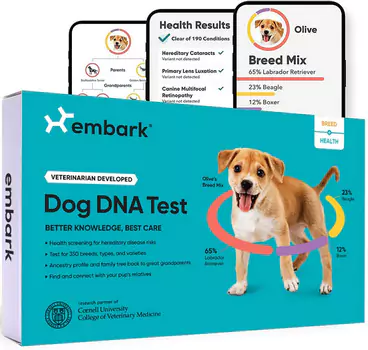
EMBARK Dog DNA Test - Discover Ancestry, Health, Traits & Allergies
Shop Amazon >
#6. Blue Merle Shelties can ace conformation
Blue Merles can compete and win champion status at dog shows, alongside purebred Shelties of Sable, Tri Color, and Bi Color coats. In conformation, judges assess Shelties on how closely they meet the Shetland Sheepdog breed standard.
While it may look like a beauty pageant, it's actually a way to determine their capacity to produce puppies with the optimal appearance, temperament, and gait. If it seems awfully fussy and perfectionist—it is! Breed standards and conformation help maintain the quality of the 190 official dog breeds in the world today.
In the video below you can see various Sheltie colors competing at the Westminster Kennel Dog Club Show, each demonstrating a well-proportioned body, a thick double coat, and the characteristic sweet expression. Judges are looking for any deviation from the breed standard; for Blue Merle Shelties, this includes coat rustiness, fading, washed-out colors, and self-color (lack of mottling).
Blue Merle Sheltie Puppies
So you've fallen in love with Blue Merle Shelties and want one in your life? Your first port of call is your nearest Sheltie rescue. While Sable Shelties are more common, you won't know until you look. Plus, adopting a Sheltie of any color is pretty awesome, so don't get hung up on the Blue Merle coat.
If you're set on a Blue Merle Sheltie puppy, search professional Sheltie breeders near you. Ethical breeders occasionally have pet-quality puppies for sale that don't meet the strict breed standard. Check their websites or reach out to be on their waiting list.
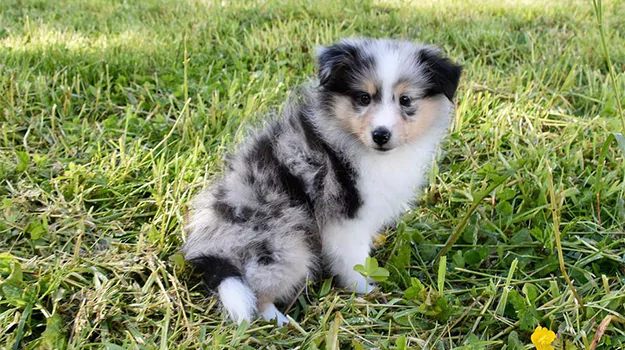
Find a Blue Merle Sheltie puppy from a reputable breeder.
When searching for a Blue Merle Sheltie puppy, choose a breeder who prioritizes health and temperament over coat color. Reputable breeders perform health screenings, provide proper socialization, and adhere to ethical breeding practices to ensure the wellbeing of their dogs.
To ensure you're buying a well-bred Blue Merle Sheltie, ask the breeder about their breeding program, health testing, and any relevant certifications. Visiting the breeder's kennels and meeting the puppy's parents can also give you a better idea of the puppy's health and temperament.
Just want to gaze at some Blue Merle puppies? Check out these photos of 101 cute Sheltie puppies from our readers. And take a moment to see a Blue Merle Sheltie doing some awesome agility stunts:
